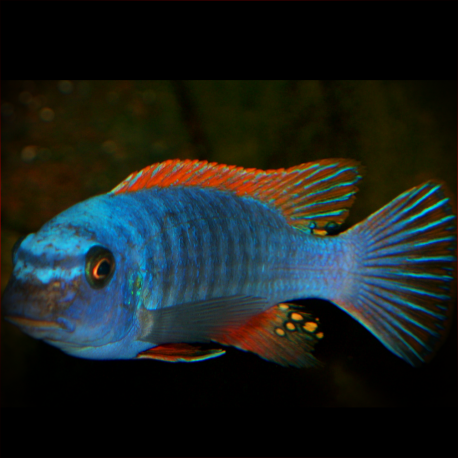More info
Datasheet
| Minimum Tank Size | 160 litres / 42.27 US gallons |
| Maximum Size | 11.2cm / 4.41inches |
| Temperature | 24°C / 75.20°F - 28°C / 82.40°F |
| Hardness | 10-25ºdH |
| pH | 7.6-8.8 |
General Description
The Trewavas' Cichlid (Labeotropheus Trewavasae) is characterized by its overhanging snout and chisel-shaped teeth, ideal for scraping algae off rocks. With over 40 natural color forms, it exhibits variability in dorsal fin coloration. This species is distinguishable from similar ones by its slender body shape and smaller adult size. Endemic to Lake Malawi, it thrives in rocky areas with abundant algal growth in shallow, turbulent waters.
Aquarium Setup
To house the Trewavas' Cichlid, a tank of at least 160 liters is recommended, with a setup including rock formations creating caves and open sandy spaces. The water should be well-oxygenated, with pH levels between 7.6-8.8, hardness from 10-25 dH, and a temperature range of 24-28°C. Avoid adding plants as they are likely to be consumed by the cichlids.
Behaviour
Known for its aggressiveness and territorial nature, the Trewavas' Cichlid is incompatible with peaceful species like Peacocks or Utaka. Maintaining an overcrowded tank can help reduce aggression, with the presence of heterospecifics aiding in mitigating aggressive behavior among conspecifics. It is advised to keep multiple females per male to minimize male harassment.
Feeding and Diet
This cichlid species is omnivorous, accepting a variety of foods but requiring a substantial portion of vegetable matter such as spirulina flakes and blanched spinach. Their diet can be supplemented with live and frozen food varieties for optimal nutrition.
Reproduction & Dimorphism
Reproduction in the Trewavas' Cichlid is possible, with the species being maternal mouthbrooders. Spawning in a species tank with a harem setup of one male and at least three females is recommended. The male displays intense coloration to attract females for mating. Females carry the brood in their mouths before releasing free-swimming fry. Males exhibit clear egg spots on the anal fin, distinguishing them from females.
Habitat and Distribution
Inhabiting rocky areas with dense algal growth along shorelines and islands, the Trewavas' Cichlid is primarily found in various locations within Lake Malawi, ranging from Masinje Rocks to Nkhata Bay. Its preference for turbulent, oxygen-rich waters makes it well-suited for habitats with such characteristics within the lake.

